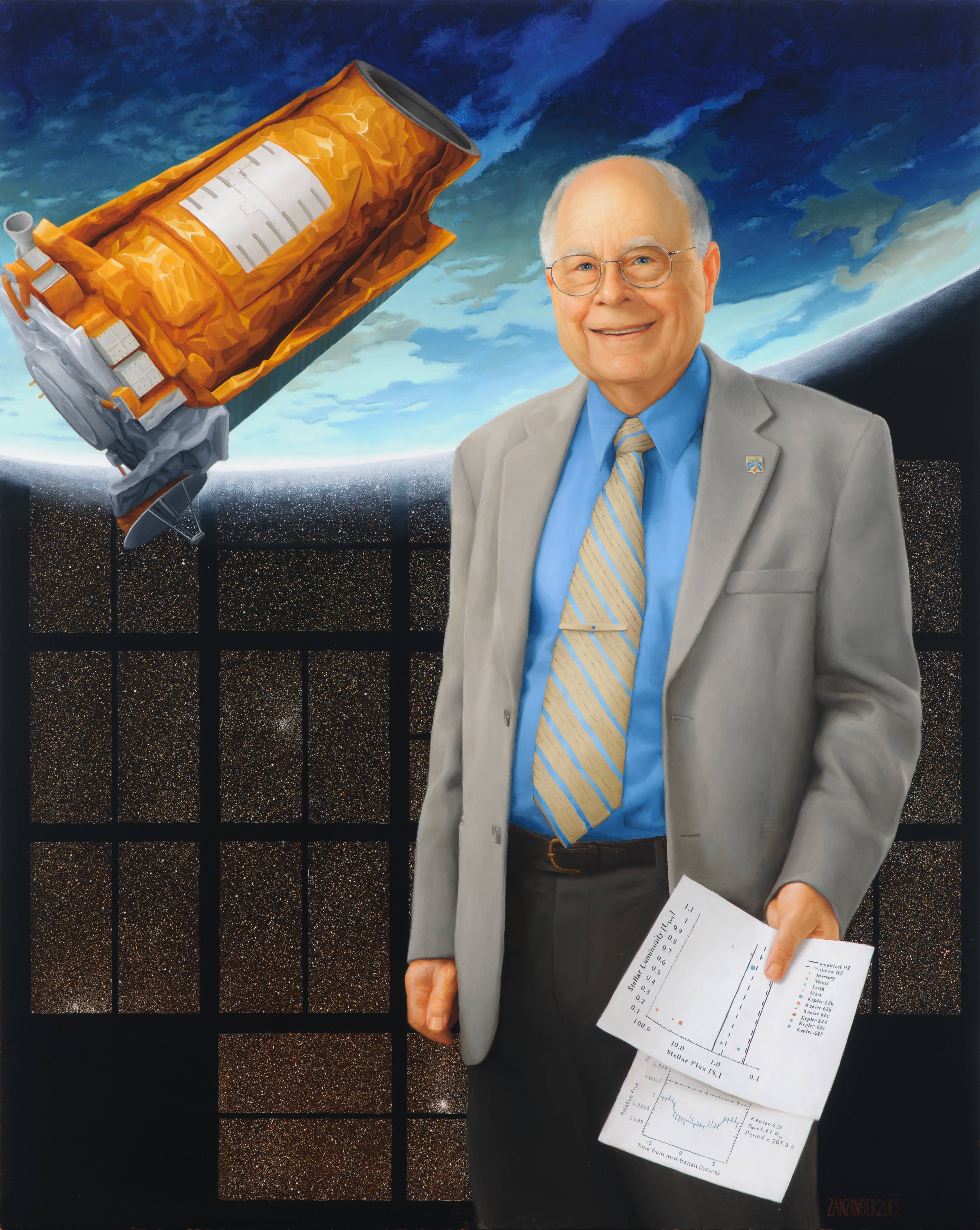William J. Borucki
William J. Borucki is an American space scientists, who works at NASA's Ames Research Center. His academic career began in 1962 with the development of the heat shield for the spacecraft of the Apollo program. His later research was focused in the study of the optical efficiency of lightning in the atmosphere and their potential for formation of organic molecules from inorganic molecules ( abiogenesis ). Borucki also deals with extrasolar planets and their discovery, specifically using the transit method. In the course of Borucki was chosen as a research project manager at NASA Kepler mission. This mission was launched on 6 March 2009 and had to search for potentially habitable extrasolar planet to the destination. For his achievements with the Kepler mission Borucki was honored by the National Academy of Sciences Henry Draper Medal with in 2013.
Education and Career
William Borucki closed in 1962 to study physics from the University of Wisconsin- Madison. Then he started with the development of the heat shield for the Apollo program to protect the spaceship and its occupants during re-entry into the atmosphere from the developed heat. After the successful moon landing, he began at the effects of nitric oxide and Fluorcarboneemissionen to determine the ozone layer of the Earth in 1972 with the development of photochemical models of the atmosphere and stratosphere. After working for the Apollo program Borucki studied at the San José State University meteorology. After completing his studies in meteorology 1982, he began at NASA with his research on the importance of flashes for the emergence abiogenetischer molecules in the atmosphere. He was also involved in the investigation of the flash frequency and distribution of other planets.
From the year 1984, Borucki focused on the observation of extrasolar Earth-sized planets using the transit method. These observations included the periodic darkening of a star that is caused by the passing of a planet along its orbit at a star. In the same year, and in 1987, Borucki organized scientific workshops that had a goal of promoting the development of methods for the transit -based Exoplanetendetektierung. Together with the National Institute of Standards and Technology photometer were developed with sufficient sensitivity. At the Lick Observatory presented Borucki those methods flaunt that were necessary to determine extrasolar planets by means of the Transmitmethode. To this end, he presented a proof of concept for a ground- powered telescope.
In 2009, Borucki was selected by NASA as a research project manager for the Kepler mission. This Space Telescope Earth-sized planets in the frequency of the habitable zone around solar-type stars should be determined. So that 242 such planets have been discovered by January 2014. For his achievements Borucki has received numerous awards, including the NASA Systems Engineering Excellence Award in 2010, the Lancelot M. Berkeley Prize in 2011, the George W. Goddard Award in 2012 and in 2013 finally the prestigious Henry Draper Medal. The latter award was justified as follows:
"For his founding concept, unflagging advocacy, visionary leadership and falling on the development of NASA 's Kepler mission, Which Has uncovered myriad planets and solar systems with unforeseen and surprising properties. "
In June 2013 William Borucki celebrated its 50th anniversary since joining NASA.
Publications (selection )
- Blomme, J., Debosscher, J., De Ridder, J., Aerts, C., Gilliland, RL, Christensen - Dalsgaard, J., Kjeldsen, H., Brown, TM, Borucki, WJ, Koch, D., et al. (2010). Automated classification of variable stars in the program Asteroseismology of the Kepler space mission. The Astrophysical Journal Letters 713, L204 - L207. doi: 10.1088/2041-8205/713/2/L204
- Borucki, WJ, Koch, D., Basri, G., Batalha, N., Brown, T., Caldwell, D., Caldwell, J., Christensen - Dalsgaard, J., Cochran, WD, Devore, E., et al. (2010). Kepler planet -detection mission: Introduction and first results. Science 327, 977-980. doi: 10.1126/science.1185402
- Borucki, WJ, Koch, DG, Basri, G., Batalha, N., Brown, TM, Bryson, ST, Caldwell, D., Christensen - Dalsgaard, J., Cochran, WD, DeVore, E., et al. ( 2011). Characteristics of planetary candidates Observed by Kepler. II Analysis of the first four months of data. The Astrophysical Journal 736 doi: 10.1088/0004-637X/736/1/19
- Chaplin, WJ, Kjeldsen, H., Bedding, TR, Christensen - Dalsgaard, J., Gilliland, RL, Kawaler, SD, Appourchaux, T., Elsworth, Y., García, RA, Houdek, G., et al. ( 2011). Predicting the detectability of oscillations in solar -type stars Observed by Kepler. The Astrophysical Journal 732 doi: 10.1088/0004-637X/732/1/54
- Doyle, LR, Carter, JA, Fabrycky, DC, Slawson, RW, Howell, SB, Winn, JN, Orosz, JA, PRSA, A., Welsh, WF, Quinn, SN, et al. ( 2011). Kepler -16: A transiting circumbinary planet. Science 333, 1602-1606. doi: 10.1126/science.1210923
- Fulchignoni, M., Ferri, F., Angrilli, F., Ball, AJ, Bar -Nun, A., Barucci, MA, Bettanini, C., Bianchini, G., Borucki, W., Colombatti, G., et al. (2005). In situ measurements of the physical characteristics of Titan 's environment. Nature 438, 785-791. doi: 10.1038/nature04314
- Gilliland, RL, Brown, TM, Christensen - Dalsgaard, J., Kjeldsen, H., Aerts, C., Appourchaux, T., Basu, S., Bedding, TR, Chaplin, WJ, Cunha, MS, et al. (2010). Kepler Asteroseismology program: Introduction and first results. Publications of the Astronomical Society of the Pacific 122, 131-143. doi: 10.1086/650399
- Hekker, S., Debosscher, J., Huber, D., Hidas, MG, De Ridder, J., Aerts, C., Stello, D., Bedding, TR, Gilliland, RL, Christensen - Dalsgaard, J., et al. (2010). Discovery of a red giant with solar -like oscillations in eclipsing binary system from Kepler to space -based photometry. The Astrophysical Journal Letters 713, L187 - L191. doi: 10.1088/2041-8205/713/2/L187
- Holman, MJ, Fabrycky, DC, Ragozzine, D., Ford, EB, Steffen, JH, Welsh, WF, Lissauer, JJ, Latham, DW, Marcy, GW, Walkowicz, LM, et al. (2010). Kepler -9: A system of multiple planets transiting a sun -like star, confirmed by timing variations. Science 330, 51-54. doi: 10.1126/science.1195778
- Jenkins, JM, Caldwell, DA, Chandrasekaran, H., Twicken, JD, Bryson, ST, Quintana, EV, Clarke, BD, Li, J., Allen, C., Tenenbaum, P., et al. ( 2010b ). Initial characteristics of Kepler long cadence data for Detecting transiting planets. The Astrophysical Journal Letters 713, L120 - L125. doi: 10.1088/2041-8205/713/2/L120
- Koch, D., Borucki, W., Webster, L., Dunham, E., Jenkins, J., Marriott, J., and Reitsema, H. ( 1998). Kepler: A space mission to detect earth- class exoplanets. pp. 599-607. doi: 10.1117/12.324482
- Cook, DG, Borucki, WJ, Basri, G., Batalha, NM, Brown, TM, Caldwell, D., Christensen - Dalsgaard, J., Cochran, WD, Devore, E., Dunham, EW, et al. (2010). Kepler mission design, Realized photometric performance, and early science. The Astrophysical Journal Letters 713, L79 - L86. doi: 10.1088/2041-8205/713/2/L79
- Lissauer, JJ, Fabrycky, DC, Ford, EB, Borucki, WJ, Fressin, F., Marcy, GW, Orosz, JA, Rowe, JF, Torres, G., Welsh, WF, et al. ( 2011). A Closely packed system of low- mass, low-density planets transiting Kepler - 11th Nature 470, 53-58. doi: 10.1038/nature09760










